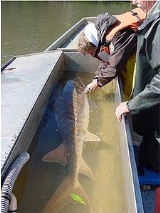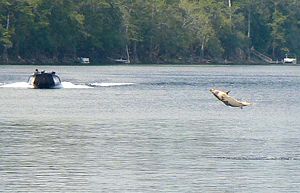
Gulf sturgeon
Encyclopedia


Subspecies
Subspecies in biological classification, is either a taxonomic rank subordinate to species, ora taxonomic unit in that rank . A subspecies cannot be recognized in isolation: a species will either be recognized as having no subspecies at all or two or more, never just one...
of sturgeon
Sturgeon
Sturgeon is the common name used for some 26 species of fish in the family Acipenseridae, including the genera Acipenser, Huso, Scaphirhynchus and Pseudoscaphirhynchus. The term includes over 20 species commonly referred to as sturgeon and several closely related species that have distinct common...
that lives in the Gulf of Mexico
Gulf of Mexico
The Gulf of Mexico is a partially landlocked ocean basin largely surrounded by the North American continent and the island of Cuba. It is bounded on the northeast, north and northwest by the Gulf Coast of the United States, on the southwest and south by Mexico, and on the southeast by Cuba. In...
and some river
River
A river is a natural watercourse, usually freshwater, flowing towards an ocean, a lake, a sea, or another river. In a few cases, a river simply flows into the ground or dries up completely before reaching another body of water. Small rivers may also be called by several other names, including...
s draining into it. The gulf sturgeon was first recognized as a separate subspecies in 1955. The nominate subspecies is the Atlantic sturgeon
Atlantic sturgeon
The Atlantic sturgeon is a member of the Acipenseridae family and is among one of the oldest fish species in the world. Its range extends from New Brunswick, Canada to the eastern coast of Florida. It was in great abundance when the first settlers came to America, but has since declined due to...
, Acipenser oxyrhynchus oxyrinchus. The gulf sturgeon is listed as threatened under the United States Endangered Species Act
Endangered Species Act
The Endangered Species Act of 1973 is one of the dozens of United States environmental laws passed in the 1970s. Signed into law by President Richard Nixon on December 28, 1973, it was designed to protect critically imperiled species from extinction as a "consequence of economic growth and...
, having been listed in 1991. Critical habitat, reflecting the current range of the subspecies, has been designated (see map). The historical range is thought to have been from the Suwanee River on the western coast of Florida
Florida
Florida is a state in the southeastern United States, located on the nation's Atlantic and Gulf coasts. It is bordered to the west by the Gulf of Mexico, to the north by Alabama and Georgia and to the east by the Atlantic Ocean. With a population of 18,801,310 as measured by the 2010 census, it...
to the Mississippi River
Mississippi River
The Mississippi River is the largest river system in North America. Flowing entirely in the United States, this river rises in western Minnesota and meanders slowly southwards for to the Mississippi River Delta at the Gulf of Mexico. With its many tributaries, the Mississippi's watershed drains...
, and marine waters of the central and eastern portions of the Gulf of Mexico. Three sturgeon species in genus Scaphirhynchus
Scaphirhynchus
Scaphirhynchus is a genus of threatened sturgeons native to the United States of America. It contains three species:*Scaphirhynchus albus...
share river territory with the Gulf sturgeon; none of these are anadromous.
Physical appearance
Visually, Gulf sturgeon are almost impossible to differentiate from Atlantic sturgeon, as the most significant morphological difference is the spleenSpleen
The spleen is an organ found in virtually all vertebrate animals with important roles in regard to red blood cells and the immune system. In humans, it is located in the left upper quadrant of the abdomen. It removes old red blood cells and holds a reserve of blood in case of hemorrhagic shock...
length, which is internal. Gulf sturgeon have a spleen length averaging 12.3% of their fork length, while Atlantic sturgeon have a spleen length averaging 5.7% of their fork length. Lesser morphological differences include relative head length, shape of dorsal scute
Scute
A scute or scutum is a bony external plate or scale, as on the shell of a turtle, the skin of crocodilians, the feet of some birds or the anterior portion of the mesonotum in insects.-Properties:...
s, and pectoral fin length. Genetic
Genetics
Genetics , a discipline of biology, is the science of genes, heredity, and variation in living organisms....
differences between the subspecies have been studied, and tend to indicate that reproductive isolation occurred in the Pleistocene
Pleistocene
The Pleistocene is the epoch from 2,588,000 to 11,700 years BP that spans the world's recent period of repeated glaciations. The name pleistocene is derived from the Greek and ....
period. Behavioral differences are more clear, especially the dietary habits. Adult Gulf sturgeon eat primarily, or possibly only, during the winter months when they are in marine
Seawater
Seawater is water from a sea or ocean. On average, seawater in the world's oceans has a salinity of about 3.5% . This means that every kilogram of seawater has approximately of dissolved salts . The average density of seawater at the ocean surface is 1.025 g/ml...
or brackish water
Brackish water
Brackish water is water that has more salinity than fresh water, but not as much as seawater. It may result from mixing of seawater with fresh water, as in estuaries, or it may occur in brackish fossil aquifers. The word comes from the Middle Dutch root "brak," meaning "salty"...
, and eat little to nothing during the remainder of the year when they are in rivers. Their weights vary in accordance with this eating pattern, with significant weight gains in the winter and smaller weight losses in the summers. Their diet consists of bottom-dwelling organisms including mollusk
Mollusca
The Mollusca , common name molluscs or mollusksSpelled mollusks in the USA, see reasons given in Rosenberg's ; for the spelling mollusc see the reasons given by , is a large phylum of invertebrate animals. There are around 85,000 recognized extant species of molluscs. Mollusca is the largest...
s, grass shrimp, marine worms, isopods
Isopoda
Isopods are an order of peracarid crustaceans, including familiar animals such as woodlice and pill bugs. The name Isopoda derives from the Greek roots and...
and amphipods
Amphipoda
Amphipoda is an order of malacostracan crustaceans with no carapace and generally with laterally compressed bodies. The name amphipoda means "different-footed", and refers to the different forms of appendages, unlike isopods, where all the legs are alike. Of the 7,000 species, 5,500 are classified...
. The reason for this seasonal eating pattern is unknown.
Life cycle
Juvenile Gulf sturgeon remain in the spawning river until roughly two years of age, eating there. Thereafter, they join the adults in their anadromous migrationsFish migration
Many types of fish migrate on a regular basis, on time scales ranging from daily to annually or longer, and over distances ranging from a few metres to thousands of kilometres...
and eating habits. The upriver migration normally occurs between February and April, as river temperatures rise to between 16 and 23 degrees Celsius. Downriver migration normally begins in late September or October when water temperatures drop to 23 degrees Celsius. Males reach sexual maturity between seven and twelve years of age, females between eight and seventeen years of age. Spawning almost always occurs in the natal river, generally over a hard bottom just downstream of a spring
Spring (hydrosphere)
A spring—also known as a rising or resurgence—is a component of the hydrosphere. Specifically, it is any natural situation where water flows to the surface of the earth from underground...
on the river bottom feeding groundwater
Groundwater
Groundwater is water located beneath the ground surface in soil pore spaces and in the fractures of rock formations. A unit of rock or an unconsolidated deposit is called an aquifer when it can yield a usable quantity of water. The depth at which soil pore spaces or fractures and voids in rock...
into the river. After spawning, the adults and older juveniles collect in regions of cooler, deeper, slower flowing water, generally downstream of springs.
Jumping
All species of sturgeon will jump at times. The Gulf sturgeon does at two times; in the rivers during July and August and early in the offshore feeding period. It is conjectured that they jump in order to communicate and maintain group cohesion. Since at least 2002, boaters on the Suwannee River have accidentally run into jumping sturgeon every summer, leading to serious injuries.Population controls
Predators of the sturgeon, other than humans, are unknown but thought to have limited impact upon the species. Parasites include the fish louse Argulus stizostehi, nematodeNematode
The nematodes or roundworms are the most diverse phylum of pseudocoelomates, and one of the most diverse of all animals. Nematode species are very difficult to distinguish; over 28,000 have been described, of which over 16,000 are parasitic. It has been estimated that the total number of nematode...
s, trematodes, and leeches. No detrimental impacts from these parasites have been observed. The species also serves as host to the glochidia (larva) of three freshwater mussel
Mussel
The common name mussel is used for members of several families of clams or bivalvia mollusca, from saltwater and freshwater habitats. These groups have in common a shell whose outline is elongated and asymmetrical compared with other edible clams, which are often more or less rounded or oval.The...
species. Overfishing and dam construction probably contributed to the historical decline in populations.
See also
- SturgeonSturgeonSturgeon is the common name used for some 26 species of fish in the family Acipenseridae, including the genera Acipenser, Huso, Scaphirhynchus and Pseudoscaphirhynchus. The term includes over 20 species commonly referred to as sturgeon and several closely related species that have distinct common...
- Atlantic sturgeonAtlantic sturgeonThe Atlantic sturgeon is a member of the Acipenseridae family and is among one of the oldest fish species in the world. Its range extends from New Brunswick, Canada to the eastern coast of Florida. It was in great abundance when the first settlers came to America, but has since declined due to...
, Acipenser oxyrhynchus oxyrinchus, the other subspecies

